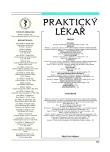The terminology of microorganisms
Názvosloví mikroorganismů
Článek si klade za úkol informovat lékaře o názvosloví neboli o nomenklatuře mikroorganismů. Tato oblast je spolu s naukou o klasifikaci a identifikaci mikroorganismů součástí taxonomie. Všechny nově popsané mikroorganismy musí být vědecky pojmenovány. Vědecké pojmenování taxonu v bakteriologii, mykologii a parazitologii je latinské a binomické a podléhá mezinárodně dohodnutým pravidlům. Práce se zabývá tvorbou názvů rodů a druhů, zejména pokud jsou odvozeny od vlastních jmen. Vysvětluje, proč v některých případech končí druhový název na jednoduché -i, v jiných na dvojité -ii. Informuje o pravidlu priority a o možnosti jeho necitlivého uplatňování. Zmíněny jsou i problémy s výslovností názvů vytvořených z vlastních jmen. Uvedeny jsou příklady názvosloví salmonel a leptospir, kde se z praktických důvodů místo druhového názvu používá název sérovaru. V názvosloví virů se předpokládá, že jako oficiální názvy druhů budou sloužit jejich vžité názvy anglické.
Klíčová slova:
taxonomie mikroorganismů – klasifikace – názvosloví – identifikace.
Authors:
M. Votava
Authors‘ workplace:
Mikrobiologický ústav LF MU a FN u svaté Anny v Brně, Brno
přednosta prof. MUDr. M. Votava, CSc.
Published in:
Prakt. Lék. 2005; 85(5): 268-272
Category:
Various Specialization
Overview
The objective of the paper is to inform physicians about the terminology or nomenclature of microorganisms. This along with the science of classification and identification of microorganisms is a component part of taxonomy. All newly described microorganisms have to be named scientifically. The scientific name of a taxon in bacteriology, mycology, and parasitology is in Latin and is binomical, being subject to internationally agreed-upon rules. The paper deals with the formation of the names of genera and species, namely when they are derived from proper names. Explained is why in certain cases the species name ends in a simple -i, and in other cases in a doubled -ii. The paper informs of the rule of priority and of the possibility of it being applied inconsiderately. Mentioned are also problems with the pronunciation of names derived from proper names. Presented are examples of the terminology of salmonellae and leptospirae, in which for all practical reasons the term serovar is used instead of species. In the terminology of viruses it is presumed that for the official names of species there shall be used their established English names.
Key words:
taxonomy – microorganisms – classification – terminology – identification.
Labels
General practitioner for children and adolescents General practitioner for adultsArticle was published in
General Practitioner

2005 Issue 5
- Metamizole at a Glance and in Practice – Effective Non-Opioid Analgesic for All Ages
- Memantine in Dementia Therapy – Current Findings and Possible Future Applications
- Advances in the Treatment of Myasthenia Gravis on the Horizon
- Possibilities of Using Metamizole in the Treatment of Acute Primary Headaches
- Hope Awakens with Early Diagnosis of Parkinson's Disease Based on Skin Odor
Most read in this issue
- Sjögren’s syndrome – a case of delayed diagnosis of malignant lymphoma with neuropsychiatric manifestations
- Paresis of the facial nerve
- The terminology of microorganisms
- Psycho-social consequences of the impairment of physical integrity
